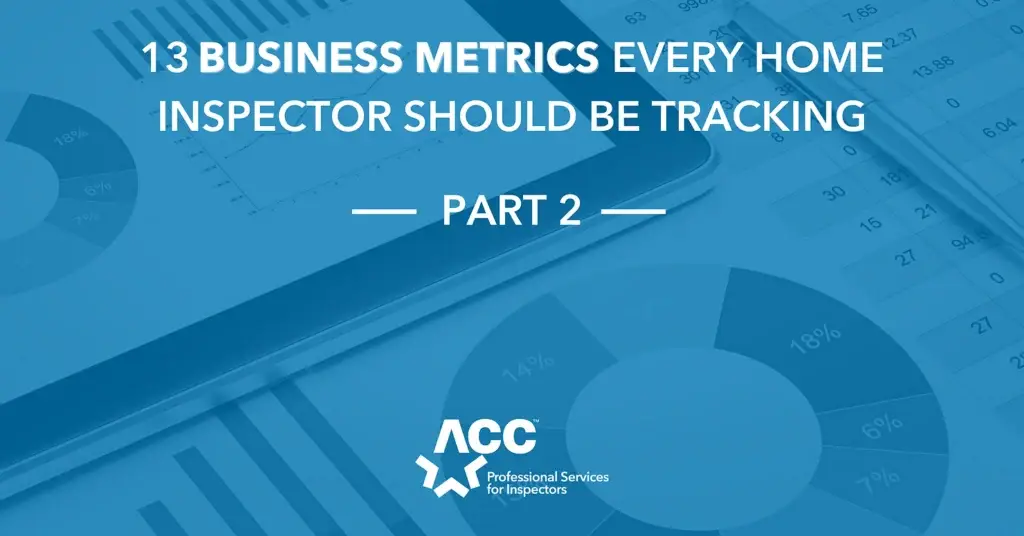[PART 2 OF 2]
In part one of this post, we explored some of the key business and financial metrics that can directly impact different aspects of your business and ultimately your profitability. Much like the previous recommendations in part one, the following front office, sales and marketing metrics are the base recommended metrics for a home inspection company. They are not exclusive – and if you have others that you track and you see value in that process, you should continue.
As a refresher, let’s briefly touch upon what exactly are business metrics, why they really matter, and what kind of an impact the tracking of specific metrics can have on your home inspection business.
First off…what are business metrics?
Depending on your experiences in the business world, business metrics can mean different things to different people in different situations. In the case of your home inspection business, it is a quantifiable measure of components of your business. They are used to track and assess the various aspects of your business – providing you a good sense of how your business is performing and if you are meeting your business goals.
Why the heck are they so important?
There are three key reasons why metrics are important to your business.
A. It will improve…
Your decision making with business decisions. Often business owners rely on their instincts when making decisions, which can be led by emotion and not objective reasoning. By looking at the data, you can avoid, or at least minimize, the emotional bias with key decisions. By relying on the facts and the data behind them, rather than an opinion, you will make better decisions that will increase the success of your business.
One example is with your pricing. Do you have data that says you cannot increase your prices 10% or more, or are you relying on your gut? By tracking a few items in your business, you can make a change, see how it impacts your business, then adjust accordingly, rather than guessing change is bad, artificially limiting your ability to grow your revenue.
B. You can track…
Your progress towards your goals. Many business owners are tracking their inspection volume, which gives them a map that both tells them where they are and the path of their home inspection journey with the number of inspections. But if you are looking to grow, by setting goals and tracking your progress in other areas (Sales and Marketing, for example) you will be able to see progress you are making and see if you may need to take other actions if improvements are needed.
C. It allows…
You to catch problems. Looking at the data over time will allow you to identify trends and spot a problem before it damages your company. For example, you notice while inspection counts are stable the number of agents using you has declined. What would happen if one or two of those top agents went away? By finding these trends early you can dig in and try to find and resolve the underlying issue before it impacts your company’s bottom line.
What should you be tracking?
As mentioned before, the recommendations below are the base recommended metrics for a home inspection company. The focus is on key metrics that can directly impact different aspects of your business and ultimately your profitability.
Front Office/Sales Metrics
7. Sales Target / Quota
If you are a one-person business, you are your sales team. As you grow, you will bring on partners (like ACC) or go through the process of hiring and managing an office staff to handle your calls, emails and texts to educate your customers to ultimately upsell and book inspections for your business. Setting targets for your team for the number of inspections performed in each month, along with the revenue generated by those inspections, allows you to know if you are on track to reach the revenue goals you have established for your business.
8. Close Rate
As experienced business owners know, not every customer contact (call, email, text, etc.) is an opportunity to provide a service to a customer. The close rate is the percentage of actual opportunities you were able to turn into a sale (revenue). To calculate your close rate, first you must be able to track and categorize your customer contacts for a given month, then simply divide by the number of inspections booked for that month.
Close rate percentage = (Total number of Sales / Total number of opportunities to sell) * 100
For example, you booked 20 inspections in the month, had a total of 150 calls of which 25 were categorized as opportunities. Your close rate would be (20/25) * 100 or 80%. Note that in this industry it can take multiple contacts to book a single inspection, so you do not want to include any additional calls past the initial outreach.
Tracking at a company and individual basis will help you identify opportunities for your company. If your close rate is high, great, you are effective at closing! If not, it is probably time to evaluate your sales process and adjust.
9. Missed Calls
There are several ways to measure this, but the simplest is “how many calls went to voicemail?” More advanced would be “how many calls were dropped after ringing for XX second?” During typical business hours for the real estate world, if a potential opportunity call goes to voice, odds are the caller will reach out to the next inspector on their list.
After tracking this metric, if you discover you or your team are seeing a significant number of missed calls, you will need to explore why. It could be a capacity issue during peak call times (too many calls, not enough people to handle them) or even something as simple as you your phone system not being able direct calls during high volume times.
10. Average Price per Inspection / Additional Services per Inspection
These metrics tend to go hand in hand, and by tracking them you will be able to see how well you and your team are able to upsell your additional services which has a direct impact on the bottom line. If you see changes in performance at a company or individual level, you will be able to take corrective action once you understand the reasons behind the changes. It might mean changing how your team approaches upselling, running promotions in your market for your additional services or evaluating if your competition is doing something new or different (for example, offering services with a package discount).
Marketing Metrics
11. New Agents
In the residential home inspection industry, revenue growth primarily comes from acquiring new clients. Those clients are typically referred by real estate agents. To make sure your business has a broad customer base and is not susceptible to a few agents changing their minds and using a different inspection company, how many new agents have you started working with every month?
Setting a goal around new agent acquisition, then tracking it, will help drive your marketing programs and better guide those investments. While this is referring to agents that have not used your services in the past, agents new to the real estate profession are also a great opportunity to “get in early”. While transaction volume with newer real estate agents is typically low, if you can find them, then help them, they will see you as a valuable partner on their team.
Knowing where your business is coming from is key in understanding the health of your business. This is where your business management software should make it easy for you to see this data via built-in reporting. Once you have the data, compare it to your goals for your business.
-
Do most of your inspections come from a few agents? If so, focusing on expanding your agent base should be a priority, in the event one of those agents stops using you for any reason (retirement, moving, you upset them…)
-
Do you have a broad base of agents using your services? If so, great! The next step is to see how the clients are distributed across those agents and see if there are opportunities to gain more of an individual agents’ business.
Combined with the other marketing metrics, this will help you focus on where you need to spend your marketing time and dollars to make sure your business is on a stable footing and ready to grow.
13. Return on Marketing Spend / Breakeven
Simply put, for every dollar you are spending on marketing, advertising, etc. how much revenue is that generating?
Return on Marketing spend = (Sales from Marketing – Marketing costs) / Marketing costs) *100
For example, you run a direct mail campaign to new real estate agents that generated four inspections from new (to your business) agents. If the revenue from those inspections was $1,600 and it cost $400 for the campaign, your return is:
(($1,600 – $400) / $400) * 100 or 300%
You can also use this a simple way to evaluate different marketing campaigns by building up your assumptions around them (how much will it cost and the potential number of inspections generated) and then comparing them.
Breakeven is another simple way to determine if the opportunity makes sense. For example, your average revenue per inspection is $400 and your gross margin is 70%. An opportunity arises for you to spend $1,000 with a local real estate agency to become a “preferred vendor” (a marketing expense) for a year. Your break-even is:
Investment / Profitability per Inspection = Number of inspections to break even
$1,000 / ($400 * 70%) = 4 inspections
If you think the arrangement will bring in at least 4 inspections during that year it is probably worth the investment but should be compared to your other marketing.
Conclusion
For new business owners, this can initially be overwhelming; so, having a business management system, and spending the time to learn and use it, is critical to your business success and growth. And even for experienced business owners, it is important to not spend your time only collecting or analyzing the data without using the insights provided by the data to actively manage your business.
The list above, and in the previous post, is a starting point for making sure you have good visibility into your business’s performance, and you will want to take the time to tailor the metrics to fit your particular needs. Having the appropriate business metrics in place ultimately allows you to steer your company towards achieving the goals you have set.


